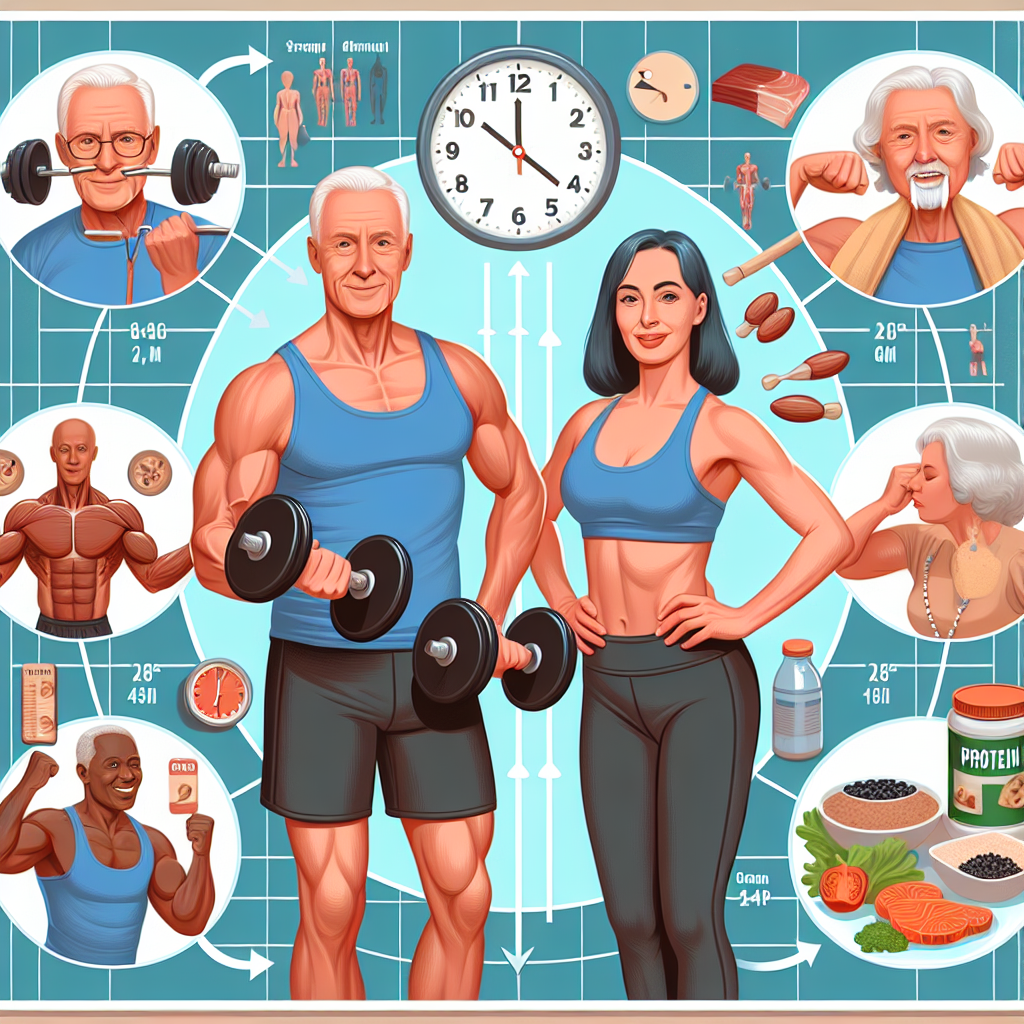A Comprehensive Guide on How to Build Muscle After 60
Age is just a number and the age of 60 is no exception, especially when it comes to muscle building. “A Comprehensive Guide on How to Build Muscle After 60” offers a clear, insightful roadmap for those in their golden years desiring vitality and strength. It artfully demystifies the concept of muscle gain at a later age, covering a multitude of aspects from nutrition to workout regimens to the necessary recovery processes. This guide is modern day “fountain of youth,” arming you with must-have knowledge to transform your physique, regardless of your birthdate!

Understanding Aging and Muscle Loss
Growing older brings many changes, and among them is an inevitable shift in our body composition. For many of us, this means a bit less fat and a bit more muscle, but what you might not realize is that there’s more to this equation than simply saying goodbye to your younger physique.
Discovering Age-Related Muscle Loss
Age-related muscle loss, also known as sarcopenia, is a common part of the aging process. Packed into each passing year is a subtle reduction in muscle mass, strength, and function. This natural condition mostly begins in your 30s but accelerates most rapidly after the age of 60. Each decade, you might lose 3–8% of your muscle mass. But don’t panic. Even though age-related muscle loss is inevitable, it’s never too late to strengthen your muscles.
Understanding Sarcopenia
Now, let’s go a little deeper into this. Sarcopenia comes from two Greek words, “sarx” which means flesh, and “penia” which means reduction, hence it implies a reduction of the flesh. This condition can cause you to lose as much as 50% of your muscle mass over time, leading to diminished strength, mobility, and balance. Sarcopenia can have severe effects on older adults, increasing the risk of falls & fractures, impairing the ability to perform daily activities and ultimately reducing life quality.
How Aging Affects Muscle Growth
Age has a significant impact on muscle growth and repair. As you age, your body’s ability to produce and synthesize proteins slows, altering the muscle repair and growth processes. The good news though is that even as an older adult, you can still engage in physical activities and exercises that can promote muscle growth and improve muscular strength and function.
The Importance of Building Muscle After 60
For those over the age of 60, continuing to build muscle is about way more than getting stronger. It’s about enhancing your overall well-being and prolonging your ability to lead an independent life.
Improving Physical Strength and Balance
One of the fundamental benefits of strength training in your older years is that it greatly increases your balance and coordination, which will help prevent falls, one of the common leading causes of injury and disability in older adults.
Increasing Metabolic rate
As you age, your metabolism tends to slow down. However, with the increase in muscle mass comes an increase in metabolic rate, which helps your body burn calories more efficiently. This means maintaining a healthier body weight becomes easier.
Enhancing Quality of Life and Longevity
By consistently engaging in strength training, you can enhance your mobility, boost your energy levels, and improve your mood. All these effects combine to improve your quality of life and potentially increase longevity.

Consulting with Healthcare Professionals
Before you embark on any new exercise program, it’s crucial to seek advice from healthcare professionals.
Discussing with Your Primary Health Care Provider
Communicate with your doctor about your intentions to start a workout program. They can assess your health status and advise you on the types and amounts of physical activity that are appropriate for you.
Getting a Physical Fitness Assessment
Consider undergoing a fitness assessment to gauge your current fitness level and identify any areas you might need to work on. This information can help you and your health care provider or trainer tailor an exercise program suited to you.
Consulting a Certified Personal Trainer
Working with a certified personal trainer can be immensely helpful, especially when starting a new physical fitness routine. They can guide you through safe and effective workout techniques, developing a regimen that caters to your unique needs and goals.
Developing a Suitable Workout Plan
Once you’ve gotten the physician’s go-ahead and consulted with a certified personal trainer, it’s time to create a workout plan.
Creating a Balanced Exercise Routine
A well-rounded exercise routine involves a blend of strength training, cardio workouts, balance exercises and flexibility workouts. The right balance of these exercises can help maintain overall health and wellness.
Incorporating Strength Training
Muscle-strengthening exercises, such as lifting weights or performing bodyweight exercises, should be a fundamental part of your workout plan. Such exercises enhance muscular strength, build lean muscle mass, and improve overall physical function.
Adjusting the Workout Plan as Needed
As you age, what works for you may change. Be flexible with your workout plan and make necessary adjustments to maintain its effectiveness.

Understanding the Role of Nutrition in Muscle Building
To complement your workout efforts, it’s; essential to feed your body with the right nutrients.
Balancing Protein Intake
Protein plays a vital role in muscle growth and repair. Try to include high-quality protein sources in your diet, such as lean meat, poultry, eggs, fish, dairy products, or plant-based alternatives like legumes and quinoa.
Hydrating Properly
Staying hydrated is critical when engaging in regular workouts. Water helps regulate body temperature, lubricate joints, and transport nutrients to give you energy.
Incorporating Essential Nutrients
Apart from protein, your body requires a balanced intake of vitamins, minerals, and carbohydrates to function well and recover from exercises. Prioritize consuming nutrient-dense foods and a balanced diet.
Safe and Effective Strength Training Techniques
Performing exercises correctly is crucial to avoid injuries and make the most out of your workouts.
Using Bodyweight Exercises
Bodyweight exercises, like squats, push-ups and lunges, can be performed without any gym equipment and are excellent for improving strength and flexibility.
Lifting Weights Safely
Improper form or attempting to lift too much weight can lead to injuries. Start with lighter loads then gradually increase the weight as your strength improves.
Incorporating Resistance Bands
Resistance bands are great for muscle strengthening. They are versatile, easy to use, and ideal for individuals at any fitness level.

Incorporating Cardiovascular Exercise
In addition to strength training, cardiovascular exercises are crucial for overall health.
Benefits of Regular Cardio Exercise
Regular cardio improves heart health, boosts lung capacity, and supports weight control. It also stimulates brain health, improves sleep, and enhances overall mood.
Recommended Cardio Routines for Seniors
Walking, swimming, cycling, and water aerobics are excellent low impact forms of cardio that older adults can take part in.
Balancing Cardio and Strength Training
Balancing strength training and cardio helps improve overall fitness. It allows you to reap the benefits of both types of exercise, from improved cardiovascular endurance to increased muscular strength.
Importance of Rest and Recovery
Allowing the body to recover after workouts is just as essential as the exercises themselves.
Understanding Muscle Recovery
Muscles need time to repair and grow after a workout. During rest periods, the body repairs muscle fibers that were damaged during exercise, promoting muscle growth.
Balancing Exercise and Rest
Over-exercising can cause more harm than good. You should include rest days in your workout routine to give your body ample time to recuperate and muscles to grow.
Sleep’s Impact on Muscle Growth
Sleep is crucial for muscle recovery and growth. An adequate night sleep provides the body with a chance to repair and rebuild tissues stressed during workouts.

Handling Injuries and Setbacks
Injuries can occur despite taking precautions. It’s crucial to know how to manage them.
Anticipating and Managing Common Injuries
Common injuries during workouts can be strains or sprains. Rest, physical therapy, and if necessary, medication can manage these injuries.
Dealing with Setbacks in Your Routine
Missed workouts or challenges can be setbacks in your routine. However, remember that consistency is key. Get back on track as soon as you can and continue with your workout regimen.
Staying Motivated Despite Challenges
Facing challenges is part of the process. Stay motivated, keep your goals in mind, and maintain a positive attitude toward aging and exercise.
FAQs on Building Muscle After 60
Here, we’ll answer some frequently asked questions on building muscle after 60.
Can you build muscle mass after 60?
Yes, you absolutely can. With proper strength training exercises and adequate nutrition, you can gain muscle mass and improve muscle strength even in your 60s and beyond.
What exercises are best for seniors?
Among the best exercises for seniors include low-impact cardiovascular workouts, like walking or swimming, along with strength-building exercises like weight lifting or resistance band workouts.
How often should seniors strength train?
The National Institute on Aging recommends that seniors engage in strength training exercises at least twice per week.
What role does diet play in muscle building?
Diet plays a significant role in muscle building. Consuming balanced meals full of high-quality protein, carbohydrates, healthy fats, and essential vitamins and minerals can support muscle growth and strength.


Pingback: The Complete Guide: How to Build Muscle After 65 – Lose Weight With Absolute Minimal Diet – Your All In One Guide to Weight Loss & Nutrition
Pingback: Mastering the Art: How to Build Muscle Over 50 for Men - Lose Weight With Absolute Minimal Diet - Your All In One Guide to Weight Loss & Nutrition
Pingback: The Guide on How to Build Muscle Mass After 60 - Lose Weight With Absolute Minimal Diet - Your All In One Guide to Weight Loss & Nutrition
Pingback: Effective Strategies On How To Build Muscle In Men Over Age 45